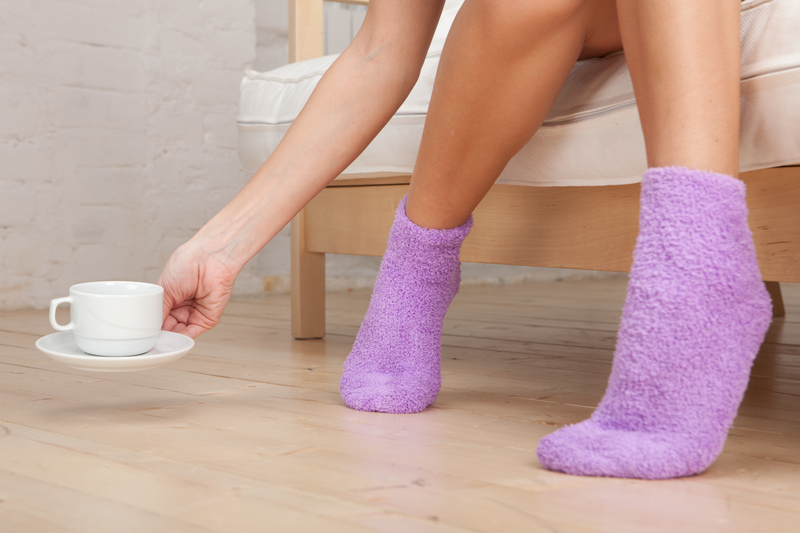Proven Methods for Safely Washing and Protecting Velvet Curtains
Posted on 09/06/2025
Proven Methods for Safely Washing and Protecting Velvet Curtains
Velvet curtains are an exquisite addition to any space, offering luxurious texture, vibrant depth of color, and a timeless sense of elegance. However, their plush fabric and delicate fibers demand special attention when it comes to cleaning and preservation. In this comprehensive guide, we will explore the best methods for washing and protecting velvet curtains to maintain their beauty and extend their lifespan. Whether you own silk velvet, cotton velvet, or synthetic variations, these expert tips and techniques will ensure your window treatments remain flawless for years to come.

Understanding Velvet Curtains: Types and Characteristics
Before delving into cleaning techniques, it's essential to recognize what makes velvet unique. Velvet is defined by its soft, dense pile and lavish appearance. Depending on the fiber content, velvet curtains can range from opulent silk velvet to durable cotton or polyester blends. Here's a quick overview:
- Silk Velvet: The most luxurious and delicate. Requires the most gentle touch and professional care.
- Cotton Velvet: Plush and sturdy, though still sensitive to water and pressure.
- Polyester/Velvet Blends: More affordable and manageable, with greater resilience to moisture and cleaning agents.
Regardless of the type, the pile construction of velvet means improper washing can result in crushed fibers, discoloration, and loss of sheen. That's why respecting the fabric's composition is crucial in the care routine.
Why Proper Care Is Essential for Velvet Curtains
Velvet curtains are an investment in home design. Improper maintenance not only dulls their exquisite appearance but may also result in permanent damage. Some of the most common problems with mistreated velvet include:
- Crushed or flattened pile
- Water stains
- Color fading or bleeding
- Shrinking and fabric distortion
- Mildew and lingering odors from improper drying
Adhering to safe washing methods for velvet curtains ensures continued vibrancy, structure, and softness for years of enjoyment.
Essential Tools and Supplies You'll Need
Prior to cleaning, gather these tools and supplies for effective and gentle maintenance of your velvet drapes:
- Upholstery or clothes brush (for dry brushing)
- Gentle vacuum cleaner with soft brush attachment
- Mild, dye-free liquid detergent
- White absorbent towels
- Spray bottle filled with distilled water
- Cotton swabs for spot testing
- Steamer or iron with steam setting
- Flat drying surface or padded hanger
Step-by-Step Guide: Cleaning and Washing Velvet Curtains
1. Always Check the Care Label First
Before any cleaning, always refer to the manufacturer's care label. Some velvet curtains are strictly dry clean only due to their composition or dye process. Ignoring this can result in irreparable harm. If the label is missing, err on the side of caution with less invasive methods described below.
2. Regular Maintenance: Brushing and Vacuuming
Frequent dusting keeps your velvet draperies looking vibrant. Use a soft upholstery brush or vacuum cleaner with a gentle brush attachment to lightly remove dust and debris. Always brush or vacuum in the direction of the pile. This prevents matting and flattening of the plush fibers while maintaining their natural luster.
3. Spot Cleaning Velvet Curtains
For minor stains or marks, a spot cleaning approach is ideal:
- Test a hidden section with a damp cotton swab and mild detergent to check for colorfastness.
- Mix a few drops of gentle, dye-free detergent with cool distilled water in a spray bottle.
- Lightly mist the stained area--do not soak the fabric.
- Gently blot (don't rub) with a white absorbent towel. Press out moisture, working in the direction of the pile.
- Allow to air dry fully away from direct sunlight or heat.
Never scrub or oversaturate velvet, as too much moisture can cause the pile to lose integrity and develop unsightly marks.
4. Hand Washing Velvet Curtains: What You Need to Know
If the care label allows water-based cleaning, hand washing is the safest approach. Here's how to hand wash velvet curtains:
- Fill a large clean bathtub or sink with cold water.
- Add a small amount of mild detergent, mixing gently to avoid sudsing.
- Immerse one curtain panel at a time.
- Gently agitate with your hands, avoiding wringing or twisting.
- Rinse thoroughly with cool, clean water.
- Remove excess water by pressing the panel between two towels--never wring.
- Lay the curtain flat on a clean, dry towel to reshape and air dry, keeping it away from direct heat or sunlight.
Tip: To maintain the velvet's softness and sheen, gently brush the pile with an upholstery brush once completely dry, following the direction of the fibers.
5. Machine Washing Velvet Curtains: Proceed With Caution
Most real velvet (especially silk or cotton) should not be machine washed, but some newer synthetic blends may be labeled as safe for mechanical washing. If permitted:
- Use a delicate or hand wash cycle with cold water only.
- Place curtains in a mesh laundry bag for extra protection.
- Use minimal mild detergent and avoid fabric softeners or bleach.
- Do not use spin dryers--gently press out water instead.
- Remove promptly and lay flat to dry as with hand washing.
Warning: If unsure, always hand wash or consult a professional dry cleaner to prevent shrinking, stretching, or pile damage.
6. Professional Dry Cleaning: The Best Option for Valuable Velvet Curtains
For antique, expensive, or 100% silk velvet curtains, professional dry cleaning is the recommended option. Professional cleaners have the proper solvents and machinery to safely refresh velvet fibers without water or agitation.
- Choose a reputable cleaner experienced with velvet textiles.
- Alert the cleaner to any stains, embellishments, or color concerns before service.
- Inspect finished curtains for any issues before taking them home.
Drying and Restoring Velvet Curtains After Washing
1. Proper Drying Techniques
Velvet should never be tumble dried or exposed to direct heat. Lay curtain panels flat on a clean, dry towel and allow them to air dry fully. If space is limited, hang curtains from a thick, padded hanger to help retain their shape. Avoid folding or creasing, which can press the pile flat.
2. How to De-Wrinkle Velvet Curtains
- To remove wrinkles, use a handheld steamer a few inches away from the fabric.
- Gently steam in the direction of the pile.
- If a steamer isn't available, use an iron on a steam setting--never let the metal plate touch the velvet! Place a cotton cloth between the iron and the curtain for extra protection.
This helps restore the plush, even texture and prevents permanent crease marks.
How to Protect Velvet Drapes Between Cleanings
Regular care will keep your velvet window curtains looking and feeling like new. Here are proven strategies for ongoing protection:
- Shield from Direct Sunlight: Sunlight can fade colors and weaken fibers over time. Use blinds or sheers to reduce UV exposure if possible.
- Control Humidity: Moisture promotes mildew growth and can cause water marks. Keep rooms well-ventilated and avoid installing velvet curtains in kitchens or bathrooms.
- Dust Weekly: Lightly brush or vacuum as part of your regular cleaning routine.
- Handle Carefully: Always have clean hands when touching velvet drapes to avoid transferring oils or dirt.
- Avoid Heavy Accessories: Tiebacks or tassels can compress velvet over time. Use wide, soft holders if needed.
- Rotate Curtains: If possible, rotate panels every few months to ensure even exposure to light and air.

Frequently Asked Questions About Washing and Caring for Velvet Curtains
Can I iron velvet curtains to get rid of wrinkles?
Direct ironing is not recommended for velvet. Instead, use a steamer or a garment steamer to gently relax wrinkles. If using an iron, always place a cotton pressing cloth between the iron and the fabric, and use only the steam setting.
Is it safe to wash velvet curtains in a washing machine?
Only machine wash velvet window coverings if the care label specifically states it's safe. Use a delicate cycle with cold water, and always place curtains in a mesh bag for additional protection.
How often should I clean velvet curtains?
Frequent dusting or vacuuming is usually enough for regular care. Deep cleaning or professional washing should generally be performed once a year, or as needed for visible stains or odors.
What's the best way to protect the pile on velvet curtains?
The best way to keep the pile plush is by brushing in the direction of the fibers and never rubbing or scrubbing during cleaning. Avoid direct heat and sunlight, and use a steamer to restore texture after drying.
Are velvet curtains a good choice for homes with pets or children?
Velvet can attract pet hair and dust, but with regular brushing and careful placement away from high-traffic areas, many homeowners enjoy its luxury without excessive hassle. Synthetic velvet is generally more durable for these situations than silk or cotton velvet.
Summary: Keep Your Velvet Curtains Looking Luxurious
Caring for velvet curtains is all about gentle handling, moisture control, and regular attention. Whether dry cleaning, hand washing, or using careful spot treatments, the right approach depends on your curtain's fabric composition and care guidelines. By following the proven washing and protection methods outlined in this guide, you can maintain the stunning elegance and rich texture of your velvet curtains for decades to come.
Enjoy your velvet drapes looking as flawless and inviting as the day they were new--luxury doesn't have to be high-maintenance with the right care!




